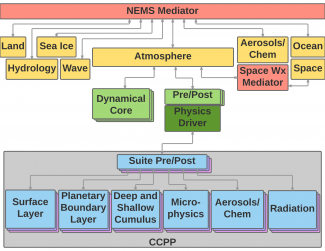While national modeling centers can benefit from the expertise in the broader community of parameterization developers, the social and technical barriers to a community researcher implementing and testing a new parameterization or set of parameterizations (a physics suite) in an operational model are high.
Physical parameterization codes are often implemented so that they are strongly linked to a particular model dynamical core, with dependencies on grid structure, prognostic variables, and even time-stepping scheme. Dependencies amongst schemes are also common. For example, information from a deep convection scheme may be needed in a gravity wave drag scheme. While the dependencies are generally justified based on computational efficiency arguments, it complicates the replacement of parameterizations and of suites, marginalizing tremendous scientific talent.
To address these difficulties, and engage the broad community of physics developers in the Weather Service’s Next-Generation Global Prediction System (NGGPS), the DTC’s Global Model Test Bed (GMTB) is participating in developing the Common Community Physics Package (CCPP). The schematic (below) shows the DTC’s proposed modeling meta-structure for NGGPS, with the CCPP shown in the gray box. Specific parameterizations in the CCPP shown here are for example only; other parameterization or set of parameterizations could be displayed in the blue boxes.
Although requirements are sure to evolve depending on priorities and funding, an initial set is in place to inform the CCPP design. They reflect the following vision for the CCPP: (1) a low barrier to entry for physics researchers to test their ideas in a sandbox, (2) a hierarchy of testing capabilities, ranging from unit tests to global model tests, (3) a set of peer-reviewed metrics for validation and verification, and (4) a community process by which new or modified parameterizations become supported within the CCPP. We recognize that an easier technical implementation path for a physical parameterization does not replace the scientific expertise necessary to ensure that it functions correctly or works well as part of a suite. A test environment intended to ease that process is also under development at GMTB, beginning with a single-column model linked to the GFS physics.
The low barrier to entry implies a highly modular code and clear dependencies. Dependencies, and the interface between physics and a dynamical core, will be handled by a thin “driver” layer (dark green box in the schematic). Variables are defined in the driver, and exchanged between model dynamics and various parameterizations. The current driver, being used for the NGGPS dynamic core test participants to run their models with the GFS physics suite, is a descendant of the National Unified Operational Prediction Capability (NUOPC) physics driver. Going forward it will be called the Interoperable Physics Driver. Continuing NUOPC input is critical to success, and the Driver development is proceeding with the NUOPC physics group’s knowledge and input.
The DTC is uniquely qualified to fulfill a leading role in physics development and community support, and the emerging CCPP is a critical element to bridge research and operations. The result will be a capability for operational centers to more rapidly adopt codes that reflect evolving scientific knowledge, and an operationally relevant environment for the broad community of physics developers to test ideas.
